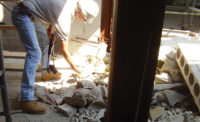Marc L. Levitan recalls being at first enthralled by the sound and light show of the thunderstorms and then traumatized by the flooding in his neighborhood in Bucks County, Pa., during 1972’s Hurricane Agnes. He was 10.
“All my toys were floating around in the basement,” says Levitan, who remembers his father rescuing a neighbor’s dog and his mother’s fear. “It was surreal,” he says.
Related Article:
Tornado-Resistant Building Design Premieres in ASCE 7-22
Back to:
25 Top Newsmakers
In Levitan’s mind, there is a link between that formative experience and his life’s work: taming the destructive power of storms. His greatest achievement to date is the historic premiere of provisions on tornado-resistant design in the structural engineers’ bible on loads.
“This is all brand new, even within the technical community,” says Levitan, lead research engineer in the National Windstorm Impact Reduction Program of the National Institute of Standards & Technology (NIST) and chair of the ASCE/SEI 7-22 task committee on tornado loads, which developed Chapter 32 of ASCE/SEI 7-22: Minimum Design Loads & Associated Criteria for Buildings & Other Structures.
“Marc’s dedication has been outstanding and single-focused,” says Donald Scott, a senior principal with PCS Structural Solutions and chair of the wind load subcommittee for ASCE 7-22. “The code will save lives as we implement it,” he adds.
Calling the standard “significant,” Scott also credits Levitan’s tornado research at NIST for the profession’s first understanding of the structure of the wind and how to design for pressure loadings on buildings.
“I like to see research benefit society,” says Levitan.
Levitan and his NIST team started working toward the goal of a national standard for tornado-resistant design soon after a twister devastated Joplin, Mo., on May 22, 2011. In 2014, NIST published a report of its investigation of the storm, led by Levitan. In it, NIST called for improved measurement and characterization of tornado hazards and new methods for tornado-resistant design of buildings.
NIST pitched the idea of a tornado chapter at the first meeting of the ASCE 7-22 wind load subcommittee, in 2018. Discussion followed, mostly about the best location for the methodology. A straw poll determined it should be part of the standard itself, not an appendix or a commentary.
Weaker Tornadoes
The provisions apply only to weaker tornadoes. Levitan says there’s a misperception that it is necessary to design for the worst tornadoes or do nothing. That’s not the case for hurricanes or earthquakes, he says. He adds that “much of the damage, on an annual basis, is done by weaker tornadoes,” because there are so many more of them.
The standard also only applies to buildings in tornado-prone regions classified as essential facilities, such as hospitals, and places of public assembly.
Currently, Levitan is working on a study of the structural cost premium for tornado design and a separate standard for wind speed estimation during strong windstorms. This work is “only in its infancy,” he says.





Post a comment to this article
Report Abusive Comment